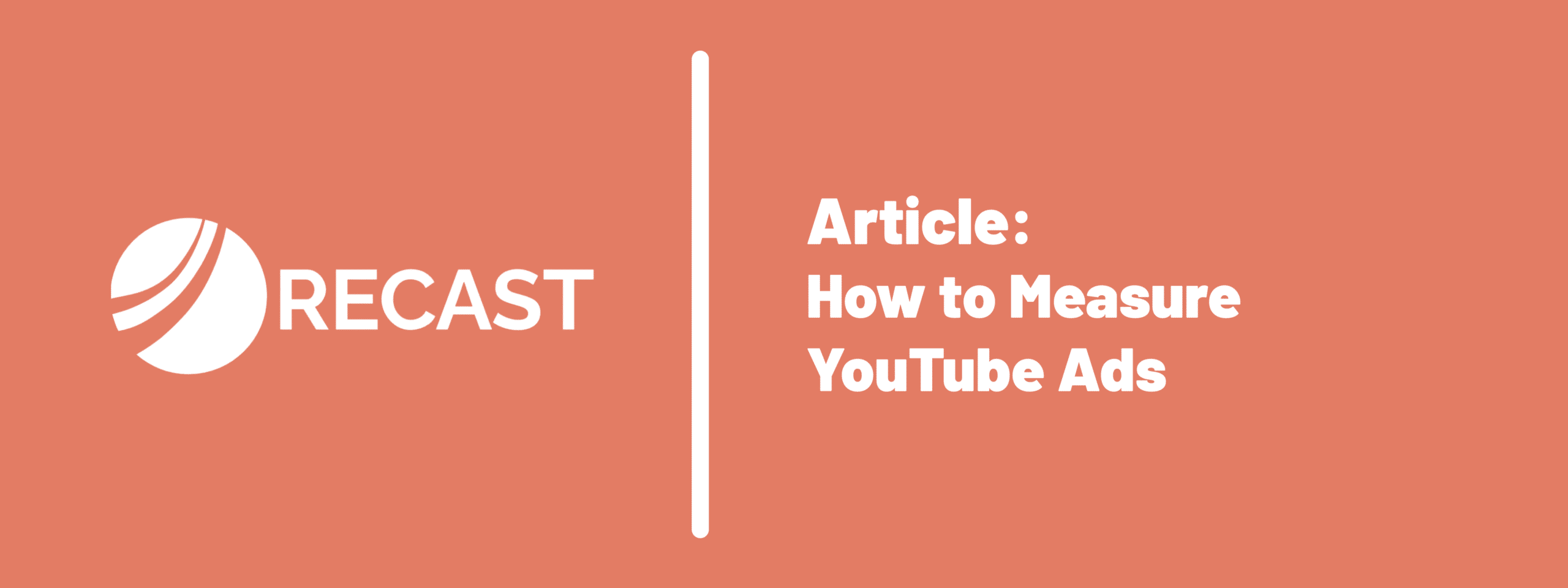YouTube is a powerful advertising platform with over 2 billion active users. However, measuring the effectiveness of YouTube ads can be challenging, especially for large brands with complex marketing mixes.
There are a number of different ways to measure YouTube ads, each with its own strengths and weaknesses. In this article, we will discuss four of the most common methods:
- Digital tracking
- HDYHAU surveys
- Geo experiments
- Marketing mix modeling
We will also discuss the challenges associated with each method and provide recommendations for how to choose the best method for your brand.
Let’s start with the most common one:
Digital Tracking
If you are just advertising on YouTube or even if you have a relatively small (under $100k / month in media spend) and simple (1-2) marketing mix of digital channels, digital tracking might be all you need.
While it doesn’t really get you closer to validating its incrementality, YouTube’s in-platform reporting can ALSO give you a pretty solid overview of campaign metrics like CPM and CPC.
If you’re also using GA4 or vendors like Northbeam and Triple Whale, last-click attribution is often the standard, though be mindful that it will ignore all the other touchpoints in the funnel. If you’re only buying media on YouTube, that’s not a huge issue – but most brands aren’t, so multi-touch attribution might be a better fit.
MTA assigns credit to all the channels that the user interacted with, but it’s definitely not perfect. After iOS14 and more privacy regulations, marketers can’t really accurately track people across the internet so take all the data with a grain of salt.
Still, digital tracking can give you directional data for small daily optimizations like turning off a poor-performing ad or adjusting campaign settings. While large brands can’t live on that alone, there is still value in it.
HDYHAU Surveys
How Did You Hear About Us surveys are a simple way to get qualitative data from your customers. It’s easy to set up, doesn’t require any sophisticated tracking software, and you won’t run into any privacy issues since it’s first-party data.
But there are challenges: you can’t really trust people’s memory, or their willingness to give accurate data, and this method overcredits more memorable channels while not giving any credit to all the other touchpoints.
That said, it can give you a data point of whether YouTube ads are prevalent in your customers’ minds as an inflection point for sales.
Geo Experiments
Once you get to $100k/mo in media spend, it’s time to think about lift tests, and geo experiments are a good one to run for YouTube ads. It works like this:
Switch off ads to a subset of the regions you tend to advertise while you keep running ads to the other regions. Then, measure the difference in sales between the control and test regions. If everything else stays the same, YouTube ads must have driven those incremental sales.
You have to be careful with how you define regions, what regions you select, and how long you run the test, but this is a straightforward test to understand and sell to leadership.
That said, it does come with limitations: it is an aggregate experiment that won’t give you very granular data, it can be time-consuming to run when you add setting it up plus delayed effects, and you have to deal with potential cross-contamination, saturation, and location data.
Go-dark Tests
Another experiment you can run is a go-dark test. They’re simple to run: you can turn off all your spend on YouTube ads for a certain period of time and then see if there has been a decrease in top-line sales and by how much – and see if your YouTube ads spend is incremental or not.
For example, we recently recommended that a customer turn off spend in a channel that made up 7% of their paid marketing program and we saw that their total revenue declined <1%. It just wasn’t that incremental.
If the opportunity cost is a concern, you can run it the opposite way: instead of depriving the channel of budget, you can double it. Incrementality is now found in how much sales increase as you simultaneously increase your spend.
There are still challenges with this experiment: you either risk the opportunity cost of going dark or risk increasing your budget and hitting saturation. You also need to account for brand effects since you’ll still be benefitting from previous advertising when you deprive the channel and if you double your budget on it, the effects will be still visible on the tail end of the experiment.
Marketing Mix Modeling
Once you get to $5-10M in media spend a year, MMM might start to make sense for you. The method involves building an advanced statistical model, which correlates spikes and dips in sales with events and actions in marketing. So for example, if every time you increase your YouTube budget your organic sales rise, MMM will pick that up, and vice versa.
A good model should look for true incrementality and work in collaboration with the geo and go-dark experiments we discussed earlier. It should provide you with testing recommendations to maximize data variation and get more signals while minimizing risk.
Since it doesn’t use digital tracking and it works on an aggregate level, you don’t have to worry about privacy regulations. However, you will also get less data at the granular or creative level of your YouTube campaigns.
TLDR: How should consumer brands measure YouTube ads
There is no one-size-fits-all answer to the question of how to measure YouTube ads. The best method for you will depend on your budget, marketing mix, and goals.
- If you are just starting out with YouTube ads, digital tracking, and HDYHAU surveys can be a good way to get started. These methods are relatively inexpensive and easy to implement.
- If you have a larger budget and a complex marketing mix, geo experiments, and marketing mix modeling may be better options for you. These methods are more accurate, but they are also more expensive and time-consuming to implement.
- If you can, use a combination of methods to get a more complete picture of the performance of your YouTube ads. Triangulate.



